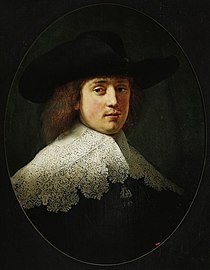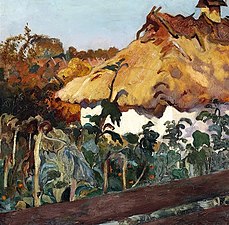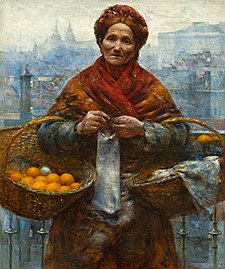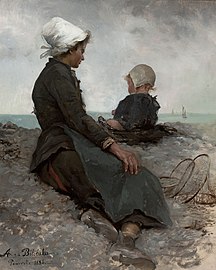Warsaw National Museum
 Lorentz courtyard of the National Museum | |
 Interactive fullscreen map | |
| Established | 20 May 1862 |
|---|---|
| Location | Aleje Jerozolimskie 3,[1] Warsaw, Poland |
| Coordinates | 52°13′54″N 21°1′29″E / 52.23167°N 21.02472°E |
| Type | National museum |
| Collections | Painting, Sculpture, Decorative arts |
| Visitors | 540,138 (2015)[2] |
| Director | Prof. Jerzy Miziołek |
| Public transit access | Tram: 7, 8, 9,22, 24, 25 Bus: 111, 117,158, 507, 517, 521 (Muzeum Narodowe) 116, 128, 195, 180, 222, 503 (Foksal)[1] |
| Website | mnw.art.pl |
The National Museum in Warsaw (Template:Lang-pl), popularly abbreviated as MNW, is a national museum in Warsaw, one of the largest museums in Poland and the largest in the capital. It comprises a rich collection of ancient art (Egyptian, Greek, Roman), counting about 11,000 pieces,[3] an extensive gallery of Polish painting since the 16th century and a collection of foreign painting (Italian, French, Flemish, Dutch, German and Russian) including some paintings from Adolf Hitler's private collection,[4] ceded to the museum by the American authorities in post-war Germany.[5] The museum is also home to numismatic collections, a gallery of applied arts and a department of oriental art, with the largest collection of Chinese art in Poland, comprising some 5,000 objects.[6]
The museum boasts the Faras Gallery with Europe's largest collection of Nubian Christian art and the Gallery of Medieval Art with artefacts from all regions historically associated with Poland, supplemented by selected works created in other regions of Europe.[7]
History
The National Museum in Warsaw was established on 20 May 1862, as the "Museum of Fine Arts, Warsaw", and in 1916 renamed "National Museum, Warsaw"[8] (with the inclusion of collections from museums and cultural institutions such as the Society of Care for Relics of the Past, the Museum of Antiquity at Warsaw University, the Museum of the Society for Encouragement of the Fine Arts, and the Museum of Industry and Agriculture).
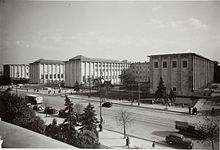
The collection, on Jerusalem Avenue, is housed in a building designed by Tadeusz Tolwiński, developed between 1927 and 1938 (earlier the museum had been located at ulica Podwale 15). In 1932 an exhibition of decorative art opened in the two earlier erected wings of the building.[3] The new building was inaugurated on 18 June 1938. The purpose-built modernistic edifice, was situated on the edge of Na Książęcem Park established between 1776–79 for Prince Kazimierz Poniatowski.[7] From 1935 the museum director was Stanisław Lorentz, who directed an effort to save the most valuable works of art during World War II.[7]
During the invasion of Poland the building was damaged and after the Siege of Warsaw the collection was looted by the Gestapo led by Nazi historian Dagobert Frey, who had already prepared a meticulous list of the most valuable artwork on official visits from Germany in 1937.[9] The Gestapo headquarters presented Rembrandt's portrait of Maerten Soolmans as a gift to Hans Frank in occupied Kraków and packed everything else to be shipped to Berlin.[10] After the war the Polish Government, under the supervision of Professor Lorentz, retrieved many of the works seized by the Germans.[11] More than 5,000 artifacts are still missing.[12]
Many works of art of, at that time unknown or of uncertain provenance[11] (e.g. originating from Nazi German art repositories in Polish Recovered Territories in Kamenz, Karthaus, Liebenthal and Rohnstock among others) were nationalized by the communist authorities[13] using subsequent decrees and acts[14] from 1945, 1946 and 1958 and were included in the museum collection as so-called abandoned property.[15] At present, the collection of the National Museum in Warsaw includes over 780,000 items displayed in many permanent galleries, including the Professor Kazimierz Michałowski Faras Gallery and galleries given over to ancient art, medieval art, painting, goldsmithing, decorative art and oriental art, as well as many temporary exhibitions.
In 2008-2013 the "Polish Archaeological Mission "Tyritake" of National Museum in Warsaw" conducted works at Tyritake, Crimea. In 2016 the "Polish Archaeological Mission "Olbia" commenced works at Olbia (archaeological site), Ukraine. Both are headed by Alfred Twardecki curator of the Ancient Art Gallery. In 2010 the National Museum, as one of the first state institutions in the world, held an exhibition entirely dedicated to homoerotic art - Ars Homo Erotica.[16] Since the 2011–12 renovation, the museum is also considered one of the most modern in Europe with a computer-led LED lighting allowing to enhance unique qualities of every painting and exhibit.[17]
In 1945 the National Museum took over the historic Nieborów Palace in the village of the same name and made them its subsidiaries. In the early perioid, the deputy curator there was the writer Mieczysław Smolarski.
Permanent galleries


In 2012 the permanent galleries underwent revolutionary changes.[18] The curators of the museum re-arranged it and supplemented it with new works from the museum's warehouses.[18] Paintings were not hung chronologically, but thematically: genre painting, still lifes, landscapes, cityscapes, biblical, mythological, nudes.[18] Works by Italian, Flemish, Dutch, German and Polish artists were hung together, making it easy to observe and compare similarities and differences.[18] The Gallery of Ancient Art, Faras Gallery, Gallery of Medieval Art, Gallery of Old Masters, Gallery of 19th-century Art and the Gallery of 20th and 21st-century, includes the works of Polish painters and sculptors and are displayed in the context of art in other countries and in different epochs.[18] The galleries reflect the richness and diversity of traditions and historical experiences of individual nations, which, however, built their cultural identity on the same foundation of Greco-Roman antiquity and the Christian religion.[19]
The Gallery of Medieval Art mainly presents objects from the late Middle Ages (14th-15th century), originating from different regions of today's Poland, as well as several examples of western European art.[20] These works were originally designed almost exclusively for churches.[20] The exhibition was designed to allow the audience to understand the role of art in the religious life of the Middle Ages.[20]
The gallery presents trans-regional phenomena from the 12th–14th centuries, such as the distinction of figurative sculpture from architecture in the Romanesque era, Central European sculpture from the circle of the Madonnas on the Lion, and so-called International Gothic, also referred to as a courtly style.[20] Many of the works included in the exhibition underline a distinct character of Central European regions such as Silesia between 1440 and 1520 (with large quartered polyptychs, epitaphs, votive and didactic plaques, and Ways of the Cross), Lesser Poland, Greater Poland and Kuyavia between 1440 and 1520 (with altarpieces and devotional paintings) and Gdańsk and the Hanseatic region between 1420 and 1520 (with large altars from Hamburg and Pomerania).[20]

The new techniques implemented in the gallery allow the unabridged presentation of large polyptychs, such as the famous Grudziądz Polyptych, including the reverse of the wings.[20] The new arrangement of the exhibition was designed by WWAA.[20]
The Gallery of Old Masters on the second floor was conceived from the former Gallery of Decorative Art, Gallery of Old European Painting and the Gallery of Old Polish and European Portrait in 2016.[21] It combines species of pictorial art - painting, sculpture, drawings and prints with crafts in reference to the very notion of "art" which originally meant craftsmanship.[21] Painting and sculpture with its representational character and imitation of reality (mimesis) was united with decorative arts in common goals and functions as well as in spaces where they were collected and exhibited.[21] These "social spaces" have provided the key to the division of the gallery: 1. palace, villa, court; 2. church, chapel and domestic altar; 3. the city. In other words: 1. court culture; 2. religious culture; 3. city culture.[21]
In the redesigned gallery, the works are presented not according to national schools, but as a confrontation of artistic circles of the South and North.[22] The new system reflects the hierarchy of the genres created by Renaissance art theory and the former function of the paintings.[22] The aim of this exhibition is to show, for what purpose and for which recipients, works of art were created.[22]

The gallery shows a variety of effigies, reflecting the multiplicity of social, political and private functions of portraiture.[23] The exhibition opens with monumental images of courtly and aristocratic portraits and busts compiled with some examples of traditional Polish and Western European portraits en pied and followed with smaller, less formal, or private portraits, coffin portraits and 18th-century portraits followed with miniature portraits and paintings of Stanislaus Augustus' era on the first floor.[23]
The core of the new exhibition of the Gallery of 19th-century Art, presenting the main trends shaping the art in the nineteenth century, is the work of Polish painters and sculptors, which is present in the context of selected works by representatives of other nationalities.[19] Confrontation of works by artists from different European countries shows their artistic aspirations, universal ideas or symbols, similar experiments carried out independently or in workshop practice.[19] One of Poland's largest canvas paintings, the Battle of Grunwald by Jan Matejko (426 cm × 987 cm (168 in × 389 in)), is displayed in the Gallery of 19th-century Art.[7]
Collections of modern and contemporary art are among the largest in Poland.[24] Paintings, sculptures, prints and drawings from the 1920s and 1930s, Polish avant-garde film, photographs, photomontages, along with selected works of the 1980s independent culture, video and performance of the last forty years are exhibited in a 700 m2 gallery.[24] Information about the selected objects is available through mobile applications and selected works are visualized and described by the gallery curator thanks to augmented reality.[24]
Collection

Collections of the National Museum in Warsaw comprise about 830,000 exhibits of Polish and foreign art, from antiquity to the present, and include paintings, sculptures, drawings, engravings, photographs and coins as well as objects of applied art and design.[25]
The Collection of Ancient and East Christian Art numbers some 24,000 exhibits, being the largest and most important of its kind in Poland.[26] The collection of frescoes from the Christian cathedral in Faras (ancient Pachoras in today's Sudan) and a collection of painted Greek vases are among the most important.[26]
The origins of the Old European Painting Collection, comprising 3,700 paintings, dates back to 1862 and the establishment of the Museum of Fine Arts, when 36 Italian, Dutch and German paintings from Johann Peter Weyer collection in Cologne were acquired.[27] The museum came into possession of the works of such masters as Pinturicchio, Cornelis van Haarlem and Jacob Jordaens.[27] The collection was enlarged through purchases, donations and deposits.[27] The most significant acquisition was the collection of paintings of Pietro Fiorentini, donated in 1858 to the School of Fine Arts in Warsaw, and given to the museum in 1879.[27] The collection was further expanded through the purchase of paintings from the collection of Wojciech Kolasiński in the years 1877–1896 and bequests by Cyprian Lachnicki in 1906 including Flagellation of Christ by Pieter de Kempeneer, Portrait of a man in a yellow jerkin by Hans Schäufelein, Expulsion from Paradise by Pier Francesco Mola and Academic study by Jean Auguste Dominique Ingres.[27]
In 1935 the museum purchased a large collection of Jan Popławski, including Portrait of Admiral by Tintoretto,[27] and in 1961 a collection of Gabriela Zapolska, including several paintings by Paul Sérusier. The collection of Polish modern art gained a more international context with the purchase of Portrait of Tadeusz Makowski by Marcel Gromaire in 1959[28] and Lassitude by an Art Deco painter Tamara de Lempicka in 1979,[29] both on permanent display. The museum also features the works of other major European artists such as Rembrandt, Sandro Botticelli, Lucas Cranach the Elder, Auguste Renoir, Gustave Courbet, Angelica Kauffmann, Luca Giordano, Mattia Preti, Joos van Cleve, Jan Brueghel the Elder, David Teniers the Younger and Gaspare Traversi.
The gallery displays a large collection of Polish history paintings of the 19th century, many of which are well-known in Polish culture, vividly depicting various incidents from the nation's history.
Collection highlights
Foreign Painting
-
Madonna and Child, Sandro Botticelli
-
Antibes - Morning, Paul Signac
-
Landscape near Cros-de-Cagnes, Pierre-Auguste Renoir
-
Landscape with Robbers Sharing Loot, Jan Brueghel the Elder
-
Holy Family with Saint John, Jacob Jordaens
-
Adoration of the Shepherds, Mattia Preti
-
Seashore, Gustave Courbet
-
Dessert, Willem Claesz. Heda
-
Adam and Eve, Lucas Cranach the Elder
-
Maerten Soolmans, Rembrandt
-
Academic Study, Jean Auguste Dominique Ingres
-
Study of a Saint, Anthony van Dyck
-
Virgin and Child with the Infant St John the Baptist, Pinturicchio
-
Portrait of a Venetian Admiral, Tintoretto
-
A Man With His Daughter, Sofonisba Anguissola
-
Choice Between Youth and Wealth, Jan Steen
Polish Painting
-
Paris in the Phrygian Cap, Antoni Brodowski
See also
Notes
- ^ a b "Informacje dla zwiedzających". mnw.art.pl. Archived from the original on 16 February 2017. Retrieved 3 March 2017.
- ^ "Dane frekwencyjne". www.mnw.art.pl. Archived from the original on 16 February 2017. Retrieved 3 March 2017.
- ^ a b Murawska-Muthesius 2001, p. 31
- ^ Schwarz, Birgit (2009). Geniewahn: Hitler und die Kunst. Böhlau Verlag Wien. p. 312. ISBN 978-32-05783-07-7.
Mehrere Gemälde aus dem Berghof befinden sich heute im Nationalmuseum in Warschau. Bordones Venus und Amor etwa (Abb. 100) ebenso wie der Madonnen-Tondo Bugiardinis (Abb. 62) oder ein großes Ruinenbild von Pannini, das in der verglasten Veranda gehangen hatte (Abb. 113).
- ^ Lorentz, Stanisław (1984). Muzeum Narodowe w Warszawie: malarstwo. Arkady. p. 28. ISBN 83-21332-01-3.
- ^ "Oriental Art Collection". mnw.art.pl. Archived from the original on 27 September 2012. Retrieved 2 March 2013.
- ^ a b c d "National Museum (Muzeum Narodowe)". www.warsawtour.pl. Archived from the original on 7 October 2013. Retrieved 20 October 2013.
The most unique are the Faras Gallery (the largest European collection of artefacts of the Nubian culture and art from the early-Christian period), the Medieval Art Gallery (unique sculptures, panel paintings and goldsmithery from all regions historically related to Poland in medieval times completed with medieval works of art created in other regions of Europe) and the largest Polish painting "Battle of Grunwald" by Jan Matejko (426 x 987 cm). (...) Behind the building, there is a picturesque park located at the Vistula Slope near Książęca Street. Back in the past, the park served as gardens of Prince Kazimierz Poniatowski (...) Prof. Lorentz headed the National Museum in Warsaw in 1936-1982 and is known for saving many valuable works of art during World War II
- ^ Folga-Januszewska 2008, p. 9
- ^ Warszawa oskarża (Warsaw accuses). Ministerstwo Kultury i Sztuki i Ministerstwo Odbudowy Kraju. 1945. p. 44. Archived from the original on 2012-02-25.
- ^ Folga-Januszewska 2008, p. 11
- ^ a b Folga-Januszewska 2008, p. 12
- ^ Monika Kuhnke. Przyczynek do historii wojennych grabieży dzieł sztuki w Polsce. Druga wojna światowa (Contribution to the history of looting in Europe. World War II) (in Polish).
- ^ Anna Trosborg (1995). Interlanguage Pragmatics: Requests, Complaints, and Apologies. Walter de Gruyter. p. 497. ISBN 31-10144-68-9.
Compare the foreign partitioning powers in the nineteenth century, the Nazi occupation during World War II, the Soviet-imposed communist regime in post-war Poland.
- ^ Stefan Hambura (2004). "Ekspertyza BSiE nr 302. IP-105 P". Reparacje wojenne w stosunkach polsko-niemieckich (War reparations in Polish-German relations) (PDF). pp. 5–6. Retrieved 9 March 2013.
- ^ "Nie zbadają zabytków w Bazylice Mariackiej. Wyjazd odwołano". polskalokalna.pl. Retrieved 9 March 2013.
W komunikacie przypomniano, że "Muzeum Narodowe w Warszawie jest właścicielem tzw. "depozytów gdańskich" na mocy Ustawy z 6 maja 1945 r. o majątkach opuszczonych i porzuconych (Dz. U. z 1945, Nr 17, poz. 97 ze zmianami) oraz Dekretu z 8 marca 1946 r. o majątkach opuszczonych i poniemieckich (Dz. U. z 1946, Nr 13, poz. 87 ze zmianami), jak również Ustawy z 25 lutego 1958 r. o uregulowaniu stanu prawnego mienia pozostającego pod zarządem państwowym (Dz. U. z 1958, Nr 11, poz. 37)".
- ^ Emilie Prattico. "Ars Homo Erotica: 'bring the toilet to Warsaw national museum'". www.cafebabel.co.uk. Retrieved 26 February 2017.
The Ars Homo Erotica exhibition opened days before the presidential elections on 20 June. It's the first art show at the largest museum of the capital to gather representations of homoeroticism in eastern Europe. When he took the national museum's helm in 2009, director Piotr Piotrowski's explicit intention was to revitalise the traditional institution.
- ^ "Warsaw Top 10" (PDF). Warsaw tour Edition nr 5, 2012. p. 20. Archived from the original (PDF) on 9 March 2013. Retrieved 1 March 2013.
The National Museum in Warsaw is also one of the most modern in Europe. Computer-led LED lighting is a feature of only select museums and galleries in Germany and the UK. The LED system allows to adjust the light to every painting so that its unique qualities are enhanced.
- ^ a b c d e Monika Kuc. "Nowe galerie i światła". www.rp.pl. Retrieved 5 July 2012.
- ^ a b c "Galeria Sztuki XIX Wieku". mnw.art.pl. Archived from the original on 4 June 2012. Retrieved 5 July 2012.
- ^ a b c d e f g Marta Dziewulska. "Nowe oblicze Galerii Sztuki Średniowiecznej Muzeum Narodowego w Warszawie". beautymission.pl. Archived from the original on 3 December 2013. Retrieved 25 November 2013.
W Galerii Sztuki Średniowiecznej MNW znajdują się głównie obiekty z okresu późnego średniowiecza (XIV–XVI w.), pochodzące z różnych regionów dzisiejszej Polski, a także kilka eksponatów z zachodu Europy. Są to dzieła, które pierwotnie przeznaczone były niemal wyłącznie do kościołów. Ekspozycja została zaprojektowana tak, aby widzowie mogli jak najlepiej zrozumieć rolę sztuki w życiu religijnym czasów średniowiecza. (...) W galerii prezentowane są ponadlokalne zjawiska sztuki XII–XV wieku, np. usamodzielnienie się rzeźby figuralnej od architektury w epoce romańskiej, środkowoeuropejska rzeźba z kręgu Madonn na Lwie, oraz tzw. międzynarodowy styl dworski, określany również jako piękny ok. 1400. Wiele włączonych do wystawy dzieł świadczy także o odrębnym charakterze ważnych dla Europy Środkowej regionów: Śląska 1440–1520 (wielkie, wieloskrzydłowe ołtarze, epitafia, tablice wotywne i dydaktyczne, droga krzyżowa), Małopolski, Wielkopolski i Kujaw 1440–1520 (ołtarze, obrazy dewocyjne) oraz Gdańska i regionu północnohanzeatyckiego 1420–1520 (z okazałymi ołtarzami z Hamburga i Pomorza). (...) Aranżacja przestrzeni wystawienniczej powierzona pracowni architektonicznej WWAA (...) Dzięki nowym rozwiązaniom konstrukcyjnym poliptyki skrzydłowe, takie jak słynny Poliptyk Grudziądzki są dostępne ze wszystkich stron, łącznie z rewersami skrzydeł, które do tej pory nie były widoczne dla widzów.
- ^ a b c d "Gallery of Old Masters". mnw.art.pl. Retrieved 25 February 2017.
- ^ a b c "Galeria Dawnego Malarstwa Europejskiego". mnw.art.pl. Archived from the original on 5 August 2012. Retrieved 5 July 2012.
- ^ a b "Galeria Portretu Staropolskiego i Europejskiego". mnw.art.pl. Archived from the original on 4 June 2012. Retrieved 5 July 2012.
- ^ a b c "Galeria Sztuki XX i XXI Wieku". mnw.art.pl. Archived from the original on 20 January 2013. Retrieved 1 March 2013.
- ^ "O Muzeum". mnw.art.pl. Retrieved 1 March 2014.
Dziś zbiory Muzeum Narodowego w Warszawie liczą ok. 830 tys. dzieł sztuki polskiej i światowej, od antyku do współczesności, i obejmują malarstwo, rzeźbę, rysunki oraz ryciny, fotografie, numizmaty, a także przedmioty sztuki użytkowej i wzornictwo.
- ^ a b "Zbiory Sztuki Starożytnej i Wschodniochrześcijańskiej". mnw.art.pl. Archived from the original on 1 March 2014. Retrieved 1 March 2014.
Zbiory Sztuki Starożytnej i Wschodniochrześcijańskiej liczą obecnie około 24 000 zabytków. Są największym i najważniejszym tego typu zespołem w Polsce. (...) Najcenniejsze są niewątpliwie kolekcja malowideł z chrześcijańskiej katedry w Faras (starożytne Pachoras, obecnie Sudan) – unikalna w skali światowej – oraz kolekcja malowanych waz greckich – najlepsza w Europie Środkowo-Wschodniej.
- ^ a b c d e f "Zbiory Dawnej Sztuki Europejskiej". mnw.art.pl. Archived from the original on 20 April 2017. Retrieved 1 March 2014.
Zbiory Dawnej Sztuki Europejskiej liczą dzisiaj ponad 3700 zabytków (...) Początki Zbiorów Dawnego Malarstwa Europejskiego sięgają 1862 roku, utworzenia Muzeum Sztuk Pięknych, kiedy dokonano zakupu 36 cennych obrazów włoskich, niderlandzkich i niemieckich na aukcji kolekcji Johanna Petera Weyera w Kolonii. Muzeum weszło wówczas w posiadanie dzieł takich mistrzów jak Pinturicchio, Cornelis van Haarlem, Jacob Jordaens. (...) Po tym wyjątkowo pomyślnym początku zbiory rozrastały się dzięki dalszym zakupom oraz darom i depozytom. Do najważniejszych nabytków należały zbiory malarstwa Pietro Fiorentiniego zapisane w 1858 na rzecz Szkoły Sztuk Pięknych oraz przekazane do Muzeum w 1879. Kolekcja powiększyła się następnie w wyniku zakupu obrazów z kolekcji Wojciecha Kolasińskiego w latach 1877–1896 oraz zapisu testamentowego Cypriana Lachnickiego z 1906 roku, przejętego w 1908 – o obrazy: Biczowanie Chrystusa Peetera Kempeneera, Portret mężczyzny w żółtym kaftanie Hansa Schäufeleina, Wygnanie z Raju Piera Francesco Moli oraz Akademickie studium nagiego mężczyzny Jean-Auguste-Dominiqueʼa Ingresa. W 1935 dokonano zakupu z dużej kolekcji obrazów Jana Popławskiego, obejmującej między innymi Portret admirała Tintoretta.
- ^ From Société des Amis de Tadé Makowski in Paris, 41.1 x 33.5, MOW 212 (212656), signed by the author - A mon cher T. Makowski avec ma vieille amitié M.G. Jan Białostocki; Maria Murdzeńska; Danuta Książkiewicz; Jan Kuglin (1969). Catalogue of paintings: foreign schools. Vol. 1. National Museum in Warsaw. p. 162.
- ^ "Lassitude". www.delempicka.org. Retrieved 16 May 2014.
1979 - National Museum Warsaw - Poland (...) one of Lempicka's paintings, "Lassitude" (B.83); the work now belongs to the permanent collections of the Museum of Modern Art of Warsaw.
References
- Folga-Januszewska, Dorota (2008), Muzeum Sztuk Pięknych i Muzeum Narodowe w Warszawie 1862-2004 (Museum of Fine Arts and the National Museum in Warsaw 1862-2004) (PDF direct download, 94.1 KB) (in Polish), National Museum in Warsaw, retrieved August 4, 2012[permanent dead link].
- Murawska-Muthesius, Katarzyna; Folga-Januszewska, Dorota (2001), National Museum in Warsaw: guide : galleries and study collections, Muzeum Narodowe w Warszawie, ISBN 83-7100-126-6
{{citation}}: CS1 maint: multiple names: authors list (link).
External links
- Official website
- Antiquities of the Black Sea, Polish-Ukrainian project of inter-museum scientific research cooperation
- Polish archaeological mission "Tyritake"
- Virtual tour of the National Museum, Warsaw provided by Google Arts & Culture
 Media related to National Museum in Warsaw at Wikimedia Commons
Media related to National Museum in Warsaw at Wikimedia Commons











